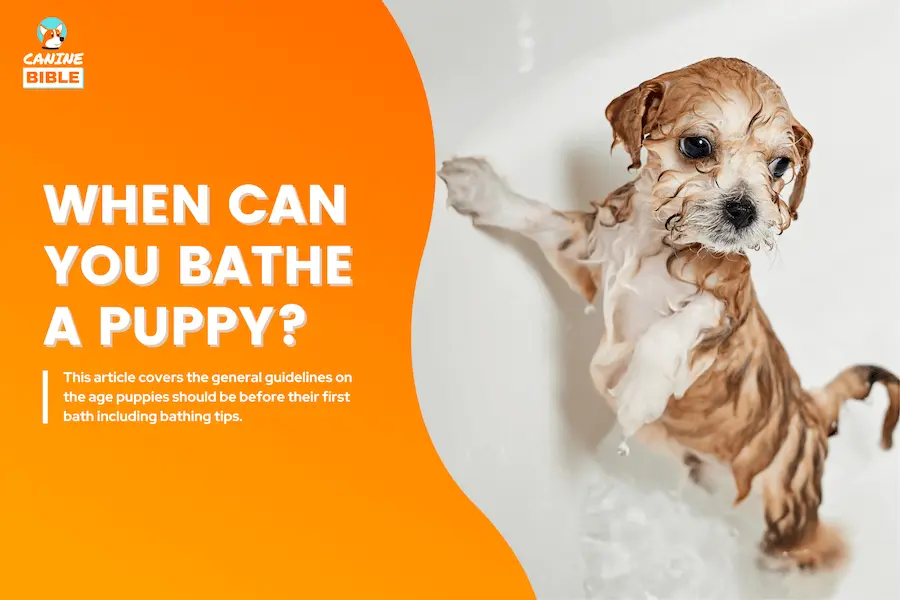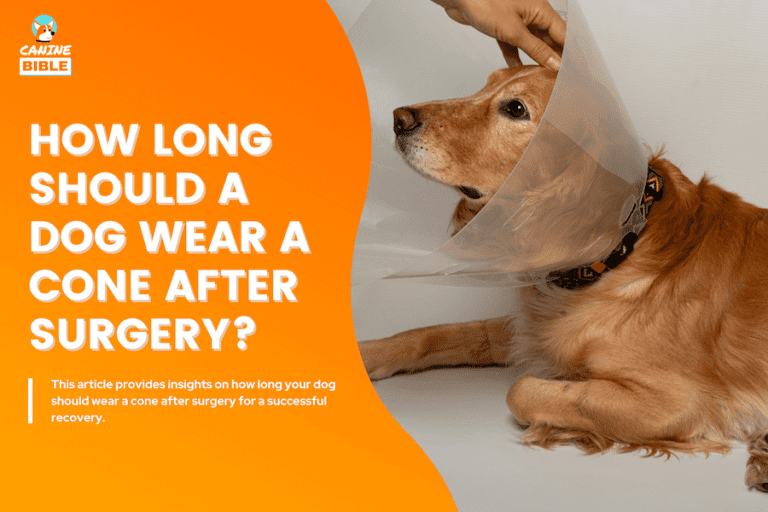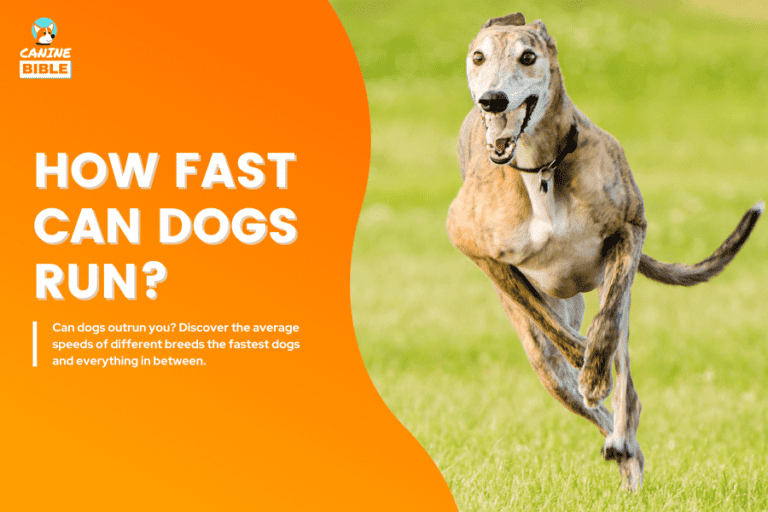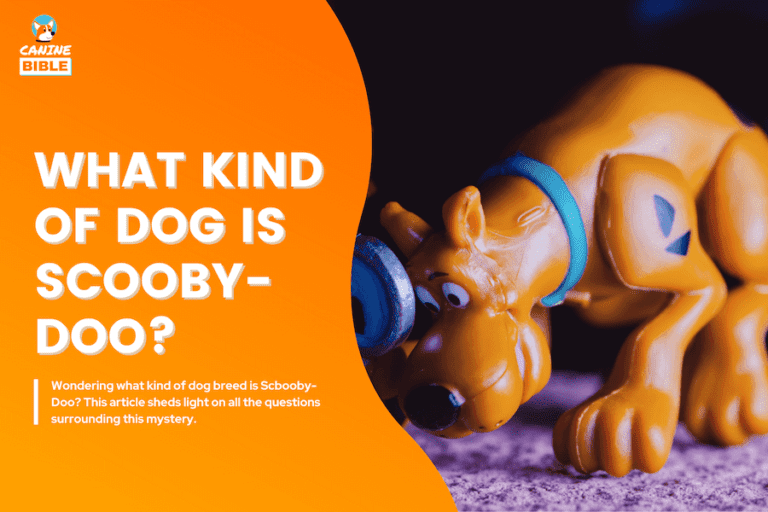When Can You Bathe A Puppy: How Old For First Bath?

Canine Bible is reader-supported. We receive affiliate commissions via some of our links. This doesn’t affect rankings. Learn more.
When can you bathe a puppy? How often should you bathe a puppy? How old does a puppy have to be to get a bath? These are questions that often come to mind for new puppy owners. While the answers may seem pretty straightforward, they depend on many factors. If you want to know at what age you can bathe a puppy, this guide covers the perfect bathing age, how to shower your puppy, how to provide you with expert puppy bathing tips, and more to ensure a happy, healthy, and clean pup.
When Can You Bathe a Puppy?
There is no set age at which a puppy should receive his first bath. Generally, it’s advised to bathe your puppy once it is 6 to 8 weeks old or older before giving it a full bath. However, most puppies are prone to getting dirty and smelly, so you may have to expedite your puppy’s first shower. If this happens and your pup is younger than 6 weeks, use bath dog wipes or a warm cloth to clean him up before putting a single drop of water on your puppy.
According to veterinarian Destini Holloway from PetCoach, puppies can regulate their body temperature after just 1 to 2 weeks old, so there is no danger of getting your puppy wet. However, waiting until your puppy is a bit older is better to avoid complications, such as getting water into your puppy’s lungs or shampoo in its eyes.
How Often Should You Bathe Your Puppy?
The answer: It depends. For instance, active dogs who spend much time outdoors rolling around in things should shower more often than dogs who spend most of their time inside the house. Your puppy bathing routine will depend on several factors, including:
Bathing your puppy as frequently as once a week is considered perfectly safe for most dogs, according to Terese DeManuelle, a veterinary dermatologist from Portland, Oregon.[1]
However, if your puppy doesn’t need a bath, bathing them once every three months or a couple of times a year may also be fine. If you are uncertain how often to wash your puppy, use your nose and eyes. If your dog starts to smell and looks not huggable, it’s probably time for a bath.
The Don’ts Of Puppy Bathing
How to Give Your Puppy A Bath: 9 Tips
Follow these simple steps to make bath time enjoyable for you and your puppy.
1. Determine Coat Needs
A puppy’s coat requires specific skincare products. Some dogs have “double coats” (the outer coat plus an undercoat), and others have water-repellent coats. The type of shampoo and conditioner you use will depend on your puppy’s fur. Research your dog’s coat-care needs and talk to your veterinarian to find out the most suitable product for your puppy. This will minimize potential coat problems and hygiene issues.
2. Gather All The Supplies
When buying shampoo, conditioners, and other products for bathing a puppy, make sure they are formulated for dogs. Select all-natural products with no additives or chemicals to avoid skin irritation or allergic reactions. Avoid selecting cheap products. Paying a little extra for high-quality and safe products is often better.
Make sure you have these items as well:
3. Positive Reinforcement (Treats)
More than a step, this is a concept to implement. Every positive behavior while showering your puppy should be rewarded with treats or assertive praise such as “good dog.” This combination of positive reinforcement will teach your dog that bathing isn’t scary.
4. Where to Bathe a Puppy
Consistency and positive association are key in this step. You want your puppy to always relate his bathing spot with a happy and fun experience. A puppy will shower just fine in the kitchen sink or bathroom. A walk-in shower or a regular bathtub is the best place for a larger breed puppy. There are also bathing puppy tubs you can purchase. If the weather is hot you can bathe your puppy outside. Just make sure the water from your garden hose or faucet has the appropriate temperature. Puppies will chill rapidly. You can use a tub, baby bathtub, or even a kiddie pool. Avoid the grass or yard for obvious reasons. You don’t want to create a mud puddle when bathing your pet.
5. Brush Your Puppy
Often overlooked by pet parents, brushing your puppy is one of the essential parts of puppy bath time. Before even turning on the water, brush your puppy thoroughly to remove tangles and knots. Be gentle when brushing, specifically in areas such as the armpits, groin, or ears. The fur in those areas tends to create firm knots. Brushing without looking can hurt your dog. If a foreign object (i.e., gum) is stuck on your dog’s fur, use scissors to trim it—cut away from the skin to avoid accidents.
Pro Tip: Brushing time is also the perfect opportunity to check for bumps, wounds, fleas, and other abnormalities that could mean a bigger health issue.
6. Use The Right Water Temperature
Never use burning hot water to bathe a dog. It will burn your dog’s skin. It’s not recommended, and most dogs don’t find it fun. Lukewarm water is ideal and will ensure your puppy’s time in the tub is positive. What it’s optimal for bathing a newborn baby should work perfectly for your puppy. Bishop-Jenkins, an internationally certified master groomer, says, “dogs’ body temperatures run higher than ours. Their experience with temperature is different from ours.” This is why it’s important to have the appropriate water temperature when bathing Fido.
7. Puppy Bath Time (Start From Botton to Top)
Assuming that you have taken care of steps 1 to 6, get ready to start washing your puppy. Puppies, like babies, aren’t used to being bathed. You need to be gentle.
8. Drying The Puppy
After the splish-splash fun is over, immediately wrap him in a dry towel. Gently rub the towel against your puppy’s fur to dry him up. If you want to speed things up, you might want to use a dog blow dryer. Set the blow drier on a low setting, at a reasonable distance from your dog, and constantly moving to avoid burning your puppy with the hot air.
9. Reward The Experience
After the bath experience, you also want to reinforce your puppy’s good behavior with his favorite treat so he can associate bathing with a happy memory.
9 Steps To Bathing Your Dog (Infographic)
Follow these nine steps for bathing a puppy in a visual format to reference easily.
Watch A Puppy Get His First Bath
Check out this video to see an experienced dog dad bathe Husky puppies using some of the tricks and techniques in this post.
Washing A Puppy Common Problems
Here are some of the most common problems when bathing a puppy.
What If My Puppy Won’t Sit Still During A Bath?
For a puppy to remain calm during bath time, teach him to associate the experience with good things. The first treat should always be given when your pup gets in the tub. You can use treats throughout the entire bathing process. Using a lick pad is an excellent trick to get your pup to sit still during a bath. Just stick the pad to the side of the tub and add peanut butter. This little puppy bathing hack should keep your puppy busy and happy during the shower so you can focus on cleaning.
What If My Puppy Is Scared of Water?
Start with small exposure. Dip your finger into water and let your puppy smell or lick it. If your pup seems calm, praise it and proceed to run your wet hand over its fur. If he reacts well, praise him again. Gradually increase water exposure over multiple weeks. A warm cloth or wipes are good tools for introducing water to your puppy.
Can I Give A Puppy A Bath Without Water?
There are a few options to contemplate. Use bath dog wipes for a quick and hassle-free bath. These specially-made wipes for dogs will remove bacteria and unpleasant odors. It’s always good to carry wipes for unforeseen accidents that could make your dog smell. Your second option would be waterless dog shampoos. Simply apply it to your dog’s coat, rub the product off, and let it dry without rinsing.
You can also sprinkle baking soda and rub it gently from neck to paws, not the face. This product soaks up any bad odors. Let sit for a couple of minutes, then brush. While these tips for bathing a puppy seem easy and quick, be careful with your eyes or breathing passages. Always consult your veterinarian to determine what’s appropriate for your dog’s breed.
Frequently Asked Questions
When Can A Puppy Take A Bath?
Improving your puppy’s hygiene is essential, and dogs enjoy being clean, just like people. We hope this guide serves you well and gets you on the right track regarding puppy bathing. Puppies can safely enjoy baths at 6 weeks old or older.
If you are curious about other ways to improve your dog’s lifestyle and health, CBD oil can be a viable option for puppies and dogs who experience anxiety, chronic pain, and cancer. We invite you to read our CBD oil for dogs guide to learn more.








